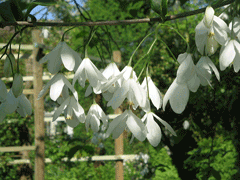 |
|
http://commons.wikimedia.org/wiki/User:Meneerke_bloem |
 |
| http://commons.wikimedia.org/wiki/User:Meneerke_bloem |
Translate this page:
Summary
Physical Characteristics

 Halesia carolina is a deciduous Tree growing to 8 m (26ft) by 10 m (32ft) at a medium rate.
Halesia carolina is a deciduous Tree growing to 8 m (26ft) by 10 m (32ft) at a medium rate.
See above for USDA hardiness. It is hardy to UK zone 5. It is in flower in May, and the seeds ripen in October. The species is hermaphrodite (has both male and female organs).
Suitable for: light (sandy) and medium (loamy) soils. Suitable pH: mildly acid and neutral soils. It cannot grow in the shade. It prefers moist soil.
UK Hardiness Map
US Hardiness Map
Synonyms
H. carolina.
Plant Habitats
Woodland Garden Secondary; Sunny Edge;
Edible Uses
Edible Parts: Fruit
Edible Uses:
The ripe fruit is chewed for its acidity[183]. Unripe fruits are sometimes pickled[2, 183].The fruit is about 4cm in diameter[200].
References More on Edible Uses
Medicinal Uses
Plants For A Future can not take any responsibility for any adverse effects from the use of plants. Always seek advice from a professional before using a plant medicinally.
None known
References More on Medicinal Uses
The Bookshop: Edible Plant Books
Our Latest books on Perennial Plants For Food Forests and Permaculture Gardens in paperback or digital formats.

Edible Tropical Plants
Food Forest Plants for Hotter Conditions: 250+ Plants For Tropical Food Forests & Permaculture Gardens.
More

Edible Temperate Plants
Plants for Your Food Forest: 500 Plants for Temperate Food Forests & Permaculture Gardens.
More

More Books
PFAF have eight books available in paperback and digital formats. Browse the shop for more information.
Shop Now
Other Uses
Wood
Wood - soft, light, close-grained[82]. It weighs 35lb per cubic foot[235]. Trees occasionally grow large enough for saw timber and are then cut and used for panelling and cabinet making[229].
Special Uses
Scented Plants
References More on Other Uses
Cultivation details
Prefers a sunny sheltered position and a deep moist sandy soil[1, 11]. Succeeds in most moist soils[184] and in most positions[11] so long as they are well-drained[202]. Requires a lime-free soil[200]. Dormant plants are hardy to about -25°c[184]. A very ornamental plant[1, 11], it has a moderate rate of growth and lives about 100 years[229]. It can flower when only 1.2 metres tall[113]. The flowers have a delicate sweet perfume[245]. The sub-species H. tetraptera monticola forms a tree about 24 metres tall. Plants in this genus are notably resistant to honey fungus[200].
References Carbon Farming Information and Carbon Sequestration Information
Temperature Converter
Type a value in the Celsius field to convert the value to Fahrenheit:
Fahrenheit:
The PFAF Bookshop
Plants For A Future have a number of books available in paperback and digital form. Book titles include Edible Plants, Edible Perennials, Edible Trees,Edible Shrubs, Woodland Gardening, and Temperate Food Forest Plants. Our new book is Food Forest Plants For Hotter Conditions (Tropical and Sub-Tropical).
Shop Now
Plant Propagation
Seed - best sown as soon as it is ripe in a cold frame[78, 113, 200]. It takes 18 months to germinate[113]. Warm stratifying the seed for 2 - 3 months at 14 - 25°c then cold stratifying for 2 - 3 months at 0 - 5°c can reduce the germination time. When they are large enough to handle, prick the seedlings out into individual pots and grow them on in the greenhouse for at least their first winter. Plant them out into their permanent positions in late spring or early summer, after the last expected frosts. Cuttings of greenwood, 5 - 8cm with a heel, May/June in a frame. Roots in 28 days. A fair percentage[78]. Layering in early spring as the buds break. Takes 12 months. High percentage[78].
Other Names
If available other names are mentioned here
Native Range
NORTHERN AMERICA: United States (Indiana, Ohio (south), West Virginia (south), Illinois (south), Oklahoma, Alabama, Arkansas, Florida (north), Georgia, Kentucky, Louisiana, Mississippi, North Carolina, South Carolina, Tennessee, Virginia (southwest))
Weed Potential
Right plant wrong place. We are currently updating this section.
Please note that a plant may be invasive in one area but may not in your area so it's worth checking.
Conservation Status
IUCN Red List of Threatened Plants Status :

Growth: S = slow M = medium F = fast. Soil: L = light (sandy) M = medium H = heavy (clay). pH: A = acid N = neutral B = basic (alkaline). Shade: F = full shade S = semi-shade N = no shade. Moisture: D = dry M = Moist We = wet Wa = water.
Now available:
Food Forest Plants for Mediterranean Conditions
350+ Perennial Plants For Mediterranean and Drier Food Forests and Permaculture Gardens.
[Paperback and eBook]
This is the third in Plants For A Future's series of plant guides for food forests tailored to
specific climate zones. Following volumes on temperate and tropical ecosystems, this book focuses
on species suited to Mediterranean conditions—regions with hot, dry summers and cool, wet winters,
often facing the added challenge of climate change.
Read More
Expert comment
Author
L.
Botanical References
1143200
Links / References
For a list of references used on this page please go here
Readers comment
© 2010, Plants For A Future. Plants For A Future is a charitable company limited by guarantee, registered in England and Wales. Charity No. 1057719, Company No. 3204567.